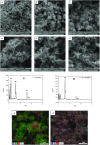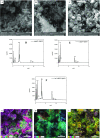Zeolitic Imidazolate Framework-8-Encapsulated Nanoparticle of Ag/Cu Composites Supported on Graphene Oxide: Synthesis and Antibacterial Activity
- PMID: 32391448
- PMCID: PMC7203699
- DOI: 10.1021/acsomega.9b03215
Zeolitic Imidazolate Framework-8-Encapsulated Nanoparticle of Ag/Cu Composites Supported on Graphene Oxide: Synthesis and Antibacterial Activity
Abstract
The rational approach motivated the design of novel antimicrobial silver and silver-copper bimetallic nanoparticles contained within zeolitic imidazolate framework-8 supported on graphene oxide (GO), Ag@ZIF-8@GO, and AgCu@ZIF8@GO. In the resultant composites, ZIF-8 was able to prevent the stacking of GO sheets and also acted as a carrier for the nanoparticles within its cavities. GO, on the other hand, acted as an anchoring support enabling uniform dispersion of the nanocomposites, thus eliminating their aggregation. The morphological and physicochemical properties of the composites were determined through a variety of characterization techniques, for example, transmission electron microscopy, scanning electron microscopy, Fourier-transform infrared spectroscopy, p-X-ray diffraction (XRD), nitrogen sorption, and X-ray photoelectron spectroscopy (XPS). The energy-dispersive system and XPS supplied evidence of the presence of all expected components in the composites. The XRD provided proof of a crystalline, distorted ZIF-8 structure. Ag@ZIF8@GO and Ag-Cu@ZIF-8@GO composites were effective against both Gram-negative (Escherichia coli) and Gram-positive (Staphylococcus aureus) bacteria as determined by the disc diffusion method. The role of silver nanoparticles (AgNPs) in the antibacterial activity of both Ag@ZIF8@GO and AgCu@ZIF8@GO was highlighted as crucial in the probable pathway in the antimicrobial activity of the composites.
Copyright © 2020 American Chemical Society.
Conflict of interest statement
The authors declare no competing financial interest.
Figures

















References
-
- Mahmoodi S.; Elmi A.; Hallaj-nezhadi S. Copper nanoparticles as antibacterial agents. J. Mol. Pharm. Org. Process Res. 2018, 06, 140.10.4172/2329-9053.1000140. - DOI
-
- Zheng K.; Setyawati M. I.; Leong D. T.; Xie J. Antimicrobial silver nanomaterials. Coord. Chem. Rev. 2018, 357, 1–17. 10.1016/j.ccr.2017.11.019. - DOI
-
- Jian W.; Ma Y.; Wu H.; Zhu X.; Wang J.; Xiong H.; Lin L.; Wu L. Fabrication of highly stable silver nanoparticles using polysaccharide-protein complexes from abalone viscera and antibacterial activity evaluation. Int. J. Biol. Macromol. 2019, 128, 839–847. 10.1016/j.ijbiomac.2019.01.197. - DOI - PubMed
LinkOut - more resources
Full Text Sources
